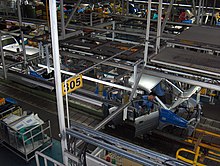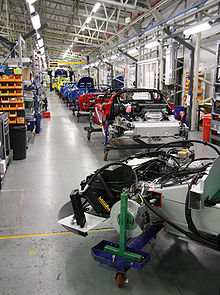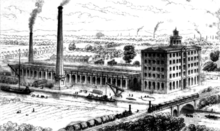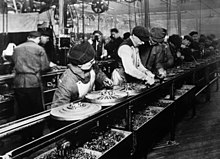Assembly line: Difference between revisions
m Reverted edits by 204.186.64.194 (talk) to last version by Phmoreno |
Tag: references removed |
||
| Line 113: | Line 113: | ||
==Sociological problems== |
==Sociological problems== |
||
[[Sociology|Sociological]] work has explored the [[social alienation]] and [[boredom]] that many workers feel because of the repetition of doing the same gfviugyhuhu hurhreh urhnrun r reer |
|||
[[Sociology|Sociological]] work has explored the [[social alienation]] and [[boredom]] that many workers feel because of the repetition of doing the same specialized task all day long.<ref>[http://links.jstor.org/sici?sici=0040-165X)6%3A3%3C518%3AAAFTFW%3E2.0.CO%3B2-J Alienation and Freedom: The Factory Worker and His Industry], [[Bob Blauner|Robert Blauner]], in ''[[Technology and Culture]]'', Vol. 6, No. 3 (Summer, 1965), pp. 518-519 {{en icon}}</ref> Because workers have to stand in the same place for hours and repeat the same motion hundreds of times per day, [[Repetitive strain injury|repetitive stress injuries]] are a possible pathology of [[occupational safety]]. [[Industrial noise]] also proved dangerous. When it was not too high, workers were often prohibited from talking. [[Charles Piaget]], a [[skilled worker]] at the [[LIP factory]], recalled that beside being prohibited from speaking, the semi-skilled workers had only 25 centimeters in which to move.<ref>[http://www.mouvements.asso.fr/spip.php?article52 Leçons d'autogestion] (Autogestion Lessons), interview with [[Charles Piaget]] {{fr icon}}</ref> Industrial [[ergonomics]] later tried to minimize physical trauma. |
|||
==Improved working conditions== |
==Improved working conditions== |
||
Revision as of 18:56, 1 March 2012

An assembly line is a manufacturing process (sometimes called progressive assembly) in which parts (usually interchangeable parts) are added to a product in a sequential manner using optimally planned logistics to create a finished product much faster than with handcrafting-type methods. The division of labour was initially discussed by Adam Smith, regarding the manufacture of pins, in his book The Wealth of Nations (published in 1776). The assembly line developed by Ford Motor Company between 1908 and 1915 made assembly lines famous in the following decade through the social ramifications of mass production, such as the affordability of the Ford Model T and the introduction of high wages for Ford workers. Henry Ford was the first to master the moving assembly line and was able to improve other aspects of industry by doing so (such as reducing labor hours required to produce a single vehicle, and increased production numbers and parts). However, the various preconditions for the development at Ford stretched far back into the 19th century, from the gradual realization of the dream of interchangeability, to the concept of reinventing workflow and job descriptions using analytical methods (the most famous example being scientific management). Ford was the first company to build large factories around the assembly line concept. Mass production via assembly lines is widely considered to be the catalyst which initiated the modern consumer culture by making possible low unit cost for manufactured goods. It is often said that Ford's production system was ingenious because it turned Ford's own workers into new customers. Put another way, Ford innovated its way to a lower price point and by doing so turned a huge potential market into a reality. Not only did this mean that Ford enjoyed much larger demand, but the resulting larger demand also allowed further economies of scale to be exploited, further depressing unit price, which tapped yet another portion of the demand curve. This bootstrapping quality of growth made Ford famous and set an example for other industries.
Concept

| External image | |
|---|---|
Assembly lines are designed for a sequential organization of workers, tools or machines, and parts. The motion of workers is minimized to the extent possible. All parts or assemblies are handled either by conveyors or motorized vehicles such as fork lifts, or gravity, with no manual trucking. Heavy lifting is done by machines such as overhead cranes or fork lifts. Each worker typically performs one simple operation.
According to Henry Ford:
- ”The principles of assembly are these:
- (1) Place the tools and the men in the sequence of the operation so that each component part shall travel the least possible distance while in the process of finishing.
- (2) Use work slides or some other form of carrier so that when a workman completes his operation, he drops the part always in the same place--which place must always be the most convenient place to his hand--and if possible have gravity carry the part to the next workman for his operation.
- (3) Use sliding assembling lines by which the parts to be assembled are delivered at convenient distances.”[1]
Simple example
Consider the assembly of a car: assume that certain steps in the assembly line are to install the engine, install the hood, and install the wheels (in that order, with arbitrary interstitial steps); only one of these steps can be done at a time. In traditional production, only one car would be assembled at a time. If engine installation takes 20 minutes, hood installation takes 5 minutes, and wheel installation takes 10 minutes, then a car can be produced every 35 minutes.
In an assembly line, car assembly is split between several stations, all working simultaneously. When one station is finished with a car, it passes it on to the next. By having three stations, a total of three different cars can be operated on at the same time, each one at a different stage of its assembly.
After finishing its work on the first car, the engine installation crew can begin working on the second car. While the engine installation crew works on the second car, the first car can be moved to the hood station and fitted with a hood, then to the wheels station and be fitted with wheels. After the engine has been installed on the second car, the second car moves to the hood assembly. At the same time, the third car moves to the engine assembly. When the third car’s engine has been mounted, it then can be moved to the hood station; meanwhile, subsequent cars (if any) can be moved to the engine installation station.
Assuming no loss of time when moving a car from one station to another, the longest stage on the assembly line determines the throughput (20 minutes for the engine installation) so a car can be produced every 20 minutes, once the first car taking 35 minutes has been produced.
History

Before the 20th century
Before the 20th century, most manufactured products were made individually by hand. A single craftsman or team of craftsmen would create each part of a product. They would use their skills and tools such as files and knives to create the individual parts. They would then assemble them into the final product, making cut-and-try changes in the parts until they fit and could work together (craft production).
The assembly line concept was independently redeveloped throughout history and not "invented" at one time by one person. Its exponentially larger development at the end of the 19th century and beginning of the 20th occurred among various people over decades, as other aspects of technology allowed. The development of toolpath control via jigs, fixtures, for machine tools (such as the screw-cutting lathe, metal planer and milling machine) during the early 19th century provided the prerequisites for the modern assembly line by making interchangeable parts a practical reality. The transition to other methods began as manufacturers took advantage of the opportunities that the aforementioned machining developments presented. Thus, before the modern assembly line took shape, there were prototypical forms in various industries, as outlined below.
Early history
The Terracotta Army commissioned by the first Chinese Emperor Qin Shi Huangdi is a collection of about 8000 life-sized ceramic soldiers and horses buried with the emperor. The figures had their separate body parts manufactured by different workshops that were later assembled to completion. Notably, each workshop inscribed its name on the part they manufactured to add traceability for quality construction.
At the peak of its efficiency in the early 16th century, the Venetian Arsenal employed some 16,000 people who apparently were able to produce nearly one ship each day, and could fit out, arm, and provision a newly-built galley with standardized parts on an assembly-line basis not seen again until the Industrial Revolution.
Industrial revolution

The Industrial Revolution in Western Europe and North America, but perhaps most especially in Great Britain and in New England, led to a proliferation of manufacturing and invention. Many industries, notably textiles, firearms, clocks and watches,[2] buttons, horse-drawn vehicles, railroad cars and locomotives, sewing machines, and bicycles, saw expeditious improvement in materials handling, machining, and assembly during the 19th century, although modern concepts such as industrial engineering and logistics had not yet been named.
Adam Smith discusses the division of labour in the manufacture of pins at length in his book The Wealth of Nations (published in 1776).
Probably the first linear and continuous assembly process of post-Renaissance times were the Portsmouth Block Mills built between 1801 and 1803. Marc Isambard Brunel (father of Isambard Kingdom Brunel), with the help of Henry Maudslay and others, designed 22 types of machine tools to make the parts for the blocks used by the Royal Navy. This factory was so successful it remained in use until the 1960s, with the workshop still visible at HM Dockyard in Portsmouth, and still containing some of the original machinery.
One of the earliest examples of almost modern factory layout, designed for easy material handling, was the Bridgewater Foundry. The factory grounds were bordered by the Bridgewater Canal and the Liverpool and Manchester Railway. The buildings were arranged in a line with a railway for carrying the work going through the buildings. Cranes were used for lifting the heavy work, which sometimes weighed in the tens of tons. The worked passed sequentially through to erection of framework and final assembly.[3]
Eli Whitney is sometimes credited[according to whom?] with developing the armory system of manufacturing in 1801, using the ideas of division of labor, engineering tolerance, and interchangeable parts to create assemblies from parts in a repeatable manner. But Whitney's contribution was mostly as a popularizer rather than "the inventor" of repeatability. He was probably[original research?] inspired by several others (including Honoré Blanc), or at least by the contemporary zeitgeist that was building around such ideas. Thomas Jefferson had tried to bring a French mechanic (almost certainly Blanc) and his methods to America in 1785, but the project never went anywhere.[4] A few years later Whitney and his American contemporaries succeeded in introducing the relevant concepts (interchangeable parts, tool-path control via machine tools and jigs, transfer of skill to the equipment, allowing use of semi-skilled or unskilled machine operators) to American firearm-manufacture.
Conveyor systems
The automatic flour mill built by Oliver Evans in 1785 was called the beginning of modern bulk material handling by Roe (1916). Evans's mill used a leather belt bucket elevator, screw conveyors, canvas belt conveyors, and other mechanical devices to completely automate the process of making flour. The innovation spread to other mills and breweries.[5][6]
Steam powered conveyor lifts began being used for loading and unloading ships some time in the last quarter of the 19th century.[7] Hounshell (1984) shows a ca. 1885 sketch of an electric powered conveyor moving cans through a filling line in a canning factory.
The meatpacking industry of Chicago is believed to be one of the first industrial assembly lines (or dis-assembly lines) to be utilized in the United States starting in 1867. Workers would stand at fixed stations and a pulley system would bring the meat to each worker and they would complete one task. Henry Ford and others have written about the influence of this slaughterhouse practice on the later developments at Ford Motor Company (see below at Ford Motor Company (1908-1915)).
Olds Motor Vehicle Company (1901)
According to a book entitled Michigan Yesterday & Today authored by Robert W. Domm, the assembly line and its basic concept is credited to Ransom Olds, who used it to build the first mass-produced automobile, the Oldsmobile Curved Dash.[8]
Olds patented the assembly line concept, which he put to work in his Olds Motor Vehicle Company factory in 1901.[9] This development is often overshadowed by Henry Ford, who perfected the assembly line by installing driven conveyor belts that could produce a Model T in ninety-three minutes.[8]
Ford Motor Company (1908-1915)

| External image | |
|---|---|
The assembly line developed for the Ford Model T began operation on December 1, 1913.[10] It had immense influence on the world. Despite oversimplistic attempts to attribute it to one man or another, it was in fact a composite development based on logic that took 7 years and plenty of intelligent men. The principal leaders are discussed below.
The basic kernel of an assembly line concept was introduced to Ford Motor Company by William "Pa" Klann upon his return from visiting a Chicago slaughterhouse and viewing what was referred to as the "disassembly line", where animals were butchered as they moved along a conveyor. The efficiency of one person removing the same piece over and over caught his attention. He reported the idea to Peter E. Martin, soon to be head of Ford production, who was doubtful at the time but encouraged him to proceed. Others at Ford have claimed to have put the idea forth to Henry Ford, but Pa Klann's slaughterhouse revelation is well documented in the archives at the Henry Ford Museum[11] and elsewhere, making him an important contributor to the modern automated assembly line concept. The process was an evolution by trial and error of a team consisting primarily of Peter E. Martin, the factory superintendent; Charles E. Sorensen, Martin's assistant; C. Harold Wills, draftsman and toolmaker; Clarence W. Avery; Charles Ebender; and József Galamb. Some of the groundwork for such development had recently been laid by the intelligent layout of machine tool placement that Walter Flanders had been doing at Ford up to 1908.
In 1922 Ford (via his ghostwriter Crowther) said of his 1913 assembly line:
- "I believe that this was the first moving line ever installed. The idea came in a general way from the overhead trolley that the Chicago packers use in dressing beef."[12]
Charles E. Sorensen, in his 1956 memoir My Forty Years with Ford, presented a different version of development that was not so much about individual “inventors” as a gradual, logical development of industrial engineering:
- "What was worked out at Ford was the practice of moving the work from one worker to another until it became a complete unit, then arranging the flow of these units at the right time and the right place to a moving final assembly line from which came a finished product. Regardless of earlier uses of some of these principles, the direct line of succession of mass production and its intensification into automation stems directly from what we worked out at Ford Motor Company between 1908 and 1913. Henry Ford is generally regarded as the father of mass production. He was not. He was the sponsor of it."[13]
As a result of these developments in method, Ford's cars came off the line in three minute intervals. This was much faster than previous methods, increasing production by eight to one (requiring 12.5 man-hours before, 1 hour 33 minutes after), while using less manpower.[2] It was so successful, paint became a bottleneck. Only japan black would dry fast enough, forcing the company to drop the variety of colors available before 1914, until fast-drying Duco lacquer was developed in 1926.[2] In 1914, an assembly line worker could buy a Model T with four months' pay.[2]
The assembly line technique was an integral part of the diffusion of the automobile into American society. Decreased costs of production allowed the cost of the Model T to drop within the budget of the American middle class. In 1908, the price of a Model T was around $825, and by 1912 it had dropped to around $575. This price reduction is comparable to a drop from $15,000 to $10,000 in dollar terms from the year 2000.
Ford's complex safety procedures—especially assigning each worker to a specific location instead of allowing them to roam about—dramatically reduced the rate of injury. The combination of high wages and high efficiency is called "Fordism", and was copied by most major industries. The efficiency gains from the assembly line also coincided with the take-off of the United States. The assembly line forced workers to work at a certain pace with very repetitive motions which led to more output per worker while other countries were using less productive methods.
Ford at one point considered suing other car companies because they used the assembly line in their production, but decided against, realizing it was essential to creation and expansion of the industry as a whole. [citation needed]
In the automotive industry, its success was dominating, and quickly spread worldwide. Ford France and Ford Britain in 1911, Ford Denmark 1923, Ford Germany 1925; in 1921, Citroen was the first native European manufacturer to adopt it. Soon, companies had to have assembly lines, or risk going broke by not being able to compete; by 1930, 250 companies which did not had disappeared.[2]
Sociological problems
Sociological work has explored the social alienation and boredom that many workers feel because of the repetition of doing the same gfviugyhuhu hurhreh urhnrun r reer
Improved working conditions
In his autobiography Henry Ford (1922) mentions several benefits of the assembly line including:
- Workers do no heavy lifting
- No stooping or bending over
- No special training required
- There are jobs that almost anyone can do
- Provided employment to immigrants
The gains in productivity allowed Ford to increase worker pay from $2.50 per day to $5.00 per day and to reduce the hourly work week while continuously lowering the Model T price. These goals appear altruistic; however, it has been argued that they were implemented by Ford in order to reduce high employee turnover.
See also
References
- ^ Ford 1922,p. 45 on line version, p80. print version.
- ^ a b c d e Georgano 1985.
- ^
Musson (1969). Science and Technology in the Industrial Revolution. University of Toronto Press. pp. 491–5.
{{cite book}}: Unknown parameter|coauthors=ignored (|author=suggested) (help) - ^ Roe 1916, pp. 129–130.
- ^ Roe, Joseph Wickham (1916), English and American Tool Builders, New Haven, Connecticut: Yale University Press, LCCN 16011753. Reprinted by McGraw-Hill, New York and London, 1926 (LCCN 27-24075); and by Lindsay Publications, Inc., Bradley, Illinois (ISBN 978-0-917914-73-7).
- ^ Hounshell, David A. (1984), From the American System to Mass Production, 1800–1932: The Development of Manufacturing Technology in the United States, Baltimore, Maryland: Johns Hopkins University Press, ISBN 978-0-8018-2975-8, LCCN 83016269, OCLC 1104810110
- ^ Wells, David A. (1890), Recent Economic Changes and Their Effect on Production and Distribution of Wealth and Well-Being of Society, New York: D. Appleton and Co., ISBN 0543724743
{{citation}}: Cite has empty unknown parameter:|coauthors=(help) - ^ a b Michigan Yesterday & Today. Voyageur Press.
- ^ Phil Ament. "Assembly Line History - Invention of the Assembly Line". Ideafinder.com. Retrieved 2011-10-15.
- ^ "Ford's assembly line starts rolling — History.com This Day in History — 12/1/1913". History. Retrieved 30 November 2011.
- ^ Klann, W. C. Reminiscences. Accession 65, Henry Ford Museum & Greenfield Village Archives.
- ^ Ford 1922, p. 81.
- ^ Sorensen 1956, p. 116.
Bibliography
- Ford, Henry; with Crowther, Samuel (1922), My Life and Work, Garden City, New York, USA: Garden City Publishing Company, Inc, ISBN 0405050887
{{citation}}: CS1 maint: multiple names: authors list (link) Various republications, including ISBN 978-1-4065-0018-9. Original is public domain in U.S. - Georgano, G. N. (1985), Cars: Early and Vintage, 1886-1930, London: Grange-Universal, ISBN 1590844912.
- Hounshell, David A. (1984), From the American System to Mass Production, 1800–1932: The Development of Manufacturing Technology in the United States, Baltimore, Maryland: Johns Hopkins University Press, ISBN 978-0-8018-2975-8, LCCN 83016269, OCLC 1104810110
- Roe, Joseph Wickham (1916), English and American Tool Builders, New Haven, Connecticut: Yale University Press, LCCN 16011753. Reprinted by McGraw-Hill, New York and London, 1926 (LCCN 27-24075); and by Lindsay Publications, Inc., Bradley, Illinois (ISBN 978-0-917914-73-7).
- Sorensen, Charles E. (1956), My Forty Years with Ford, New York: W. W. Norton, LCCN 56010854, OCLC 912748. Various republications, including ISBN 9780814332795.
- We-Min Chow (1990). Assembly Line Design.
